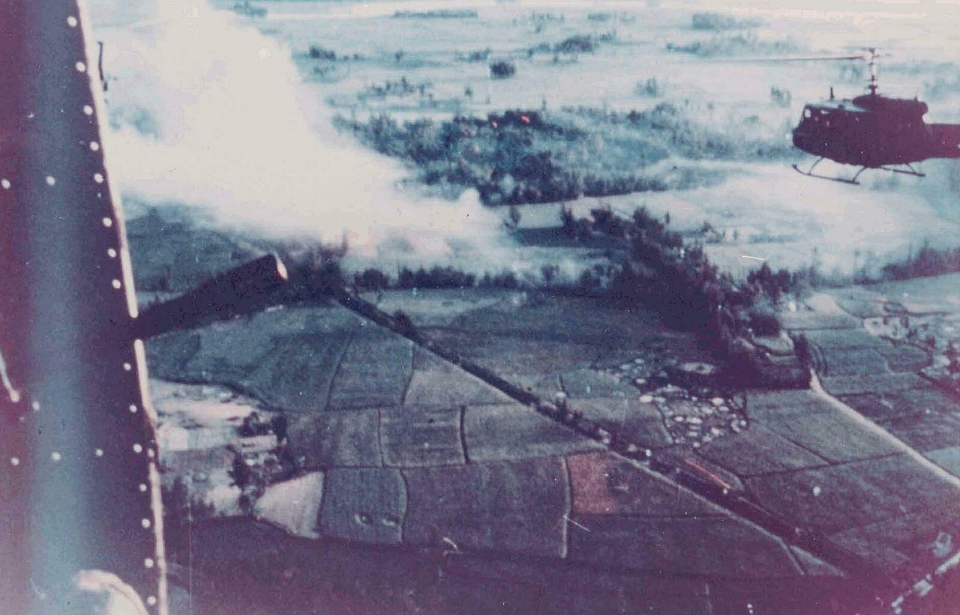The Mỹ Lai Massacre has been dubbed “the most shocking episode of the Vietnam War,” with hundreds of civilians slaughtered by American troops. It’s an event mired in controversy, and it’s a part of history that’s largely misunderstood. Many aren’t quite sure what happened on the morning of March 16, 1968, and this is something Dr. Marshall Poe hopes to rectify in his new book, The Reality of the My Lai Massacre and the Myth of the Vietnam War.
Dr. Poe is the son of a Vietnam War veteran whose speciality is Russian history. However, he has a wider interest in military and world history, authoring and editing many academic releases and teaching at Harvard, Columbia and the University of Iowa, among other post-secondary institutions. Dr. Poe is also the founder and editor-in-chief of the New Books Network, which hosts many author-interview podcasts that help bring academic books and works to a wider audience.
War History Online was recently able to interview Dr. Poe about his new book and the implications of the Mỹ Lai Massacre, not just during the Vietnam War, but in the wider context of modern society and our view on military conflict.
Overview of the Mỹ Lai Massacre
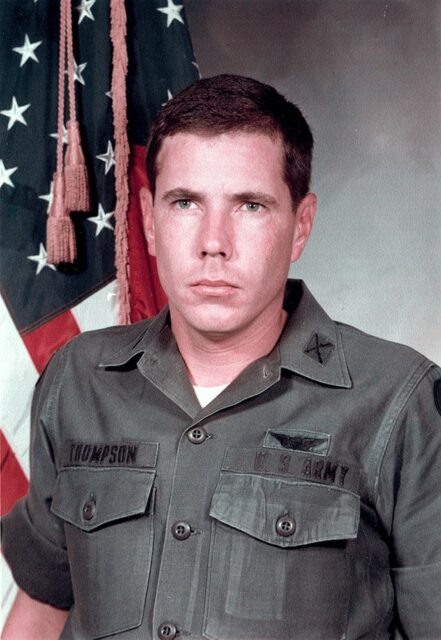
The Mỹ Lai Massacre is arguably the most infamous event of the Vietnam War. On the morning of March 16, 1968, 100 men from Company C, 1st Battalion, 20th Infantry Regiment, 11th Brigade, 23rd Infantry Division and 100 from Company B, 4th Battalion, 3rd Infantry Regiment, 11th Brigade, 23rd (Americal) Infantry Division began shelling the small village in South Vietnam. They’d expected to receive heavy retaliatory fire from Viet Cong guerrillas hiding in the community, but none came.
The attack on the village was ordered by Lt. Col. Frank Barker, the leader of Task Force Barker, and commanded by the likes of Capt. Ernest Medina and Second Lt. William Calley. Following the initial artillery barrage, the American ground troops entered Mỹ Lai, while airborne units hovered overhead in helicopters. The men had been told the village contained only enemy fighters, so they began rounding up and killing everyone they could, believing the individuals to be Viet Cong.
However, there were no guerrillas in Mỹ Lai, just regular civilians – women, children and older men.
As the carnage unfolded, some of those tasked with the attack began to realize that something was off. One such individual was Warrant Officer Hugh Thompson, Jr., who was above the scene in a Hiller OH-23 Raven. Seeing those below, including Medina, kill innocent people, Thompson and his helicopter crew did all they could to stop the massacre, putting their lives on the line to save Mỹ Lai’s residents.
When the assault was called off, the civilian fatalities were in the hundreds. The US Army put the total at 347 (the military branch initially said 128 Viet Cong and 22 civilians had lost their lives), while the Vietnamese said the total was more likely around 504. The subsequent investigation into the massacre resulted in just one person being charged and convicted: Calley. His life sentence was later commuted by the Nixon Administration.
Interview with Dr. Marshall Poe
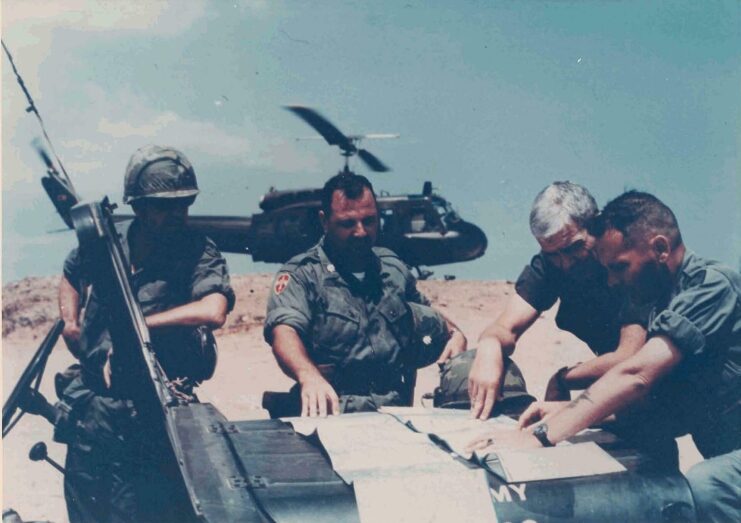
What made you want to start researching and writing a book about the Mỹ Lai Massacre?
MARSHALL POE: I listened to an interview with Seymour Hersh [in 2012], who wrote the first account of Mỹ Lai in 1971, and I remember, I was making dinner for my kids and I thought I should really read a good book by an academic historian about [it]. So I went to look, to see if there was one and there wasn’t.
I went online to see what kinds of sources were available and what I discovered was kind of amazing. In 1970, the Army started to conduct the largest investigation that it had ever conducted, and it was into the Mỹ Lai Massacre.
This is called the Peers Commission, and they produced 20,000 pages of transcripts. They interviewed everybody involved, from generals down to specialists. They interviewed hundreds of people, and they also collected 5,000 pages of official documents that were related to the incident and to the units that were involved.
I was like, that’s incredible. All the sources have been gathered for me, all I have to do is read them. I started to read them, and I looked at other accounts of Mỹ Lai and there haven’t been that many, really. It was very clear that nobody had looked at the Peers Commission testimony carefully. It was also very clear that if you read the literature that some of the things that were being said about the Vietnam War and about Mỹ Lai were not correct, so that’s really how I got into it.
When I read all the testimony, I thought what I really should do [is] reconstruct the massacre, literally minute by minute, because it all occurred basically on one morning – actually, in a couple of hours. It was kind of micro history, like what actually happened minute by minute, like how did they make the decisions they made? Why did they do what they did? And that was very revealing. It turned out there’s a lot of things that we didn’t know about it that are in the testimony.
I started looking at the literature about Mỹ Lai after the 1971 Hersh book and what I discovered was our understanding of it is very imperfect, and that’s largely for political reasons. It became a kind of political football. That’s the second half of the book, which talks about the way in which we understand Mỹ Lai today.
So the first half is just a minute by minute reconstruction of the massacre and the second half is [a] kind of history of Mỹ Lai in the American context over the last 50 years.
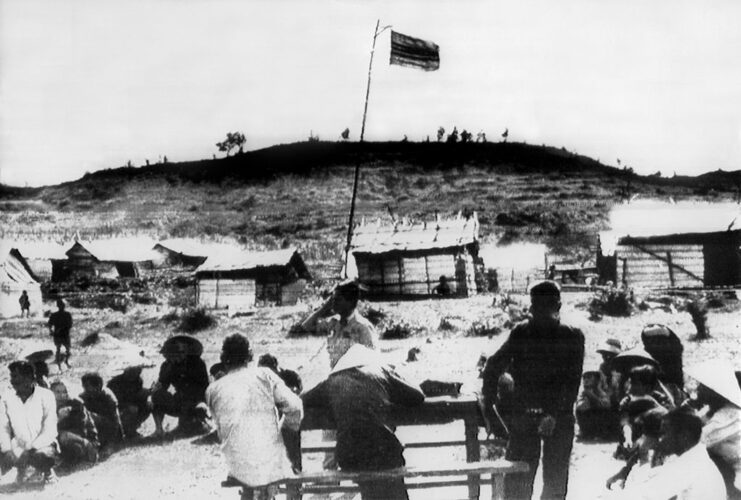
Was there anything that struck you in your research, like, wow, we really don’t know what fully happened that morning in March 1968?
MARSHALL POE: The general impression that the American public has, and this is mostly due to this political aspect I talked about, is that a lot of really angry and disgruntled GIs went into a village and just killed a bunch of civilians, and this has to do with the “crazy Vietnam vet” image, which you see all over the place in popular culture. It’s just a standard trope, but that’s not what happened at all.
There was simply a confluence of events. It was extremely unusual in Vietnam, and this is one of the takeaways of the book. The Mỹ Lai Massacre was unique. There was nothing like it in Vietnam, in the Vietnam War.
There were other atrocities, but [a] case of [a] company going into a village and killing some number of civilians. We don’t really know how many. You see 500 a lot. I don’t know where that comes from. I suspect it’s North Vietnam. The Army said it was 128, but that kind of thing, this is the only case we have like it in the Vietnam War.
The devil is in the details. To understand what happened, you really have to put yourself in the mind of the people [who] were doing it and what they wanted out of it, and I think I did a reasonably successful job of explaining what they wanted and how it all went wrong. Because they did not go into the village with the intent of killing over 100 civilians. They went into the village with the intent of destroying a Viet Cong battalion that they thought was there. That was their intent.
We can be pretty specific about why it happened, and it was a very unusual confluence of events.
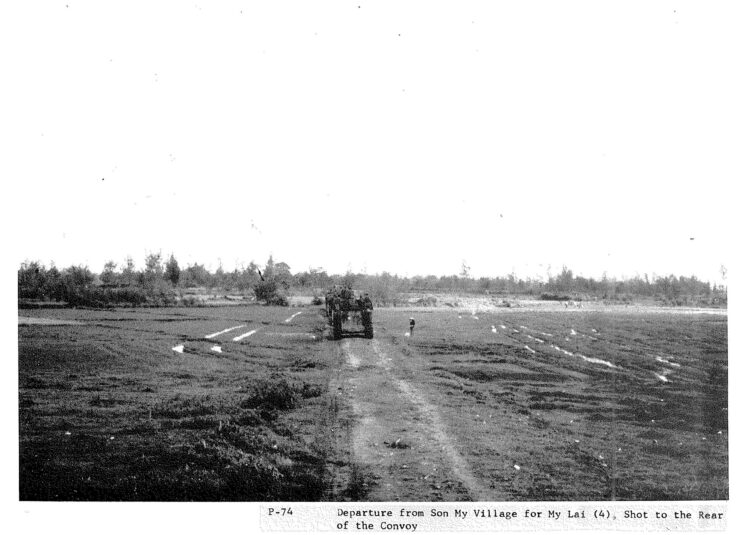
What are your opinions on the alleged cover-up that many bring up in relation to the Mỹ Lai Massacre?
MARSHALL POE: The first thing to say is, and you see this in the literature a lot, you’ll see a sentence [about it] the military covering up Mỹ Lai or the Johnson Administration covered [it up], and that’s just not true. A few people in the Army conspired to cover it up and we know who they were – and there were about five of them. We know their names. We know what they did. It wasn’t the Army.
The Army did pretty much everything it could to avoid things like Mỹ Lai, and for good reason. Because it’s bad for the war effort. I mean, they knew if there was a lot of what they call “collateral damage” or something like that, the anti-war precedent will get a hold of it. And not only on moral grounds. Obviously, soldiers don’t shoot civilians. Every American knew it was wrong to shoot civilians, everybody knew this.
The Army was very fixated on avoiding this kind of thing. I mean, there are lots of documents from the brass saying, be really careful, and in most cases they were really careful. In this case, they weren’t, and you have to ask yourself, why is that exactly?
When the charges were laid against Calley, the Army issued a press release. It was printed in The New York Times. Is that a cover up? I don’t think so. That’s how Seymour Hersh found out about it, in The New York Times. The Army just didn’t want this kind of thing. It’s just bad for business, and not to mention bad for the people who were killed, but they just wanted to avoid this kind of thing.
There was a conspiracy – actually, that conspiracy didn’t start when more people think it did, which was the day of, late in the day. It started during the operation.
Just to give you a little background. The person primarily responsible for the massacre is someone you never hear of and his name is Lt. Col. Frank Barker. He was the head of Task Force Barker and he was trying to make rank, like a lot of [soldiers in] Vietnam. He wanted a promotion and the best way to get a promotion in the Vietnam-era Army – because competition for these positions was fierce – was to get a really good result where you kill a lot of Viet Cong.
He had this in mind when he planned the Mỹ Lai operation. He came to believe that, apparently, the village of My Lai, he had attacked this village twice before in the previous months, and in both cases he reported things which were very suspicious.
He said that he killed, I think, close to 100 VC in these two operation, but he captured like seven weapons – where are the weapons? – and he only sustained a few casualties. It just didn’t make sense, and everybody knew it didn’t make sense. His superiors were wondering about this, like these operations look very weird. It doesn’t add up, and they talked about it.
You have two options. One is he had actually killed a bunch of civilians. I don’t think that happened. The other was he just inflated the body count, which is what he did. He and his staff issued a nice report, so he got a promotion.
So this was the third Mỹ Lai operation, the one that resulted in the massacre. He said something, or he claimed something, that was incredible. He said that an entire VC battalion, the 48th, was in Mỹ Lai. This gave him and Task Force Barker an opportunity to have what you might call as stand-up fight.
It [was] actually quite hard to find VC, but, according to Barker, here they are, concentrated in one place. He said – and this is the completely outrageous part – that there would be no civilians in the village. The reason he gave for this, he and his staff, was that he said all Vietnamese go to market at 8:00 AM every day.
It’s actually funny. We have these transcripts and the people who are interviewing, Barker was dead at this time, so they interview his second in command and third in command. So they say this and the people in the room who had been to Vietnam were just like, that’s insane. That doesn’t happen. Everybody knows that doesn’t happen. It’s not the case that all Vietnamese go to market at 8:00 AM. They don’t. Everybody knew this.
But by saying there would be no civilians in the village and by claiming an entire VC battalion was there, he was able to say to his troops, which he did, [that] you can go in there and just kill everybody, because everybody is VC. When they arrived at the village, they expected to receive a lot of fire, they didn’t receive any fire. You would think, [if] there’s an entire battalion in the village, well [they] would shoot at you, but that’s not what happened. It was quiet.
Now, it’s not that there weren’t VC in the area, and this is another thing, there were VC in the area and they did kill a few of them, but there were just a few. It was 8:00 AM. There they are, and they’re not receiving fire from the village.
This is very suspicious – what you can do, what they should have done to stop the operation – because intelligence, the so-called intelligence, [was] totally wrong. They should have done what they often did in situations like this, which was [to] go into the village and check everybody’s IDs, look for weapons and then move onto the next object, but that’s not what Barker said to do. Barker said to attack the village. And guess what he told Medina: attack the village.
From the troops’ perspective, everybody in the village was VC, so they go in shooting and they kill a lot of civilians, but very quickly, like within 15 minutes, they realize that something’s not right here. These are old men, women and children, and there’s no VC in the village or, if there are, they can’t find them. It’s a small village and, again, this is another point [where] the operation could have been stopped, but Barker didn’t. Medina didn’t.
It’s at that point that the cover up starts, literally 15 minutes into the operation. Medina calls back to headquarters to talk to Tactical Operations Command and says, “I killed 36 VC and captured this many weapons.” He didn’t kill any VC. He killed a bunch of civilians, so he’s already covering it up, and Barker knows about this because [he[ is overhead in a helicopter. So he knows what’s going on, too. Now, he’s implicated.
At that point, it simply became a question of how they’re going to explain all these dead civilians, and the way to do it is they claim that some of them died as a result of an artillery barrage because they shelled the village before the insertion. That’s their primary. That’s what happened. But it was almost immediately clear that things had gone horribly wrong.
The soldiers themselves who were in the village, a lot of them were just gobsmacked. They just didn’t understand because they’d been told that it was VC and there was nobody in there. Then it becomes a question of how to cover it up and that’s what they did, eventually.
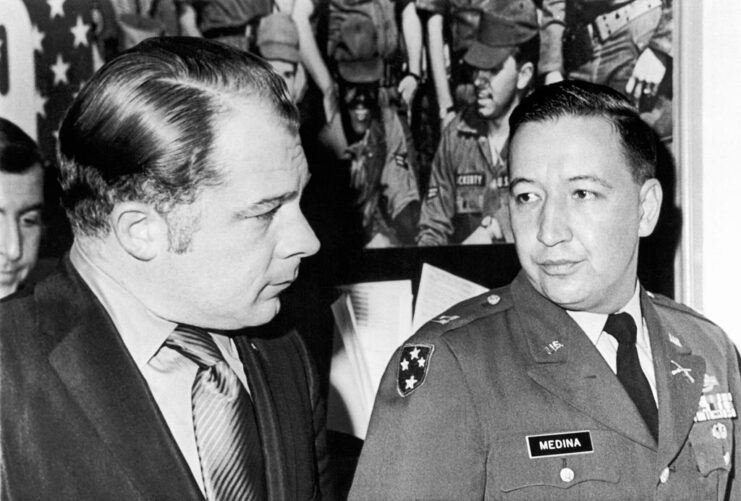
By then, it’s obvious that more than just Frank Barker are involved. From your research, why do you think just one person, William Calley, was convicted in the end?
MARSHALL POE: I don’t know, it has more to do with the [US] Army, in the way it does things. I don’t really go into that in the book, but I mean, the news in my book is that it’s Barker that’s responsible; Barker and Medina and Calley, those three, they are really the people [who] were involved in this, they [were] involved in a conspiracy. The conspiracy was essentially to cover it up.
Later, a few people are involved because there were 100 American troops in the village, there are officers overhead in helicopters. There are people like Hugh Thompson, Jr. who are flying around in his gunship. You know, it’s like they realized they had a real problem on their hands. There’s career ending, absolute career ending events. It’s over for you and your career in the Army if this gets out.
Why the Army wasn’t more aggressive? I don’t know. I can’t really answer that question. But in terms of responsibility, I place it squarely on Barker, Medina and Calley. Those are the three [who] really didn’t do what they were supposed to do.
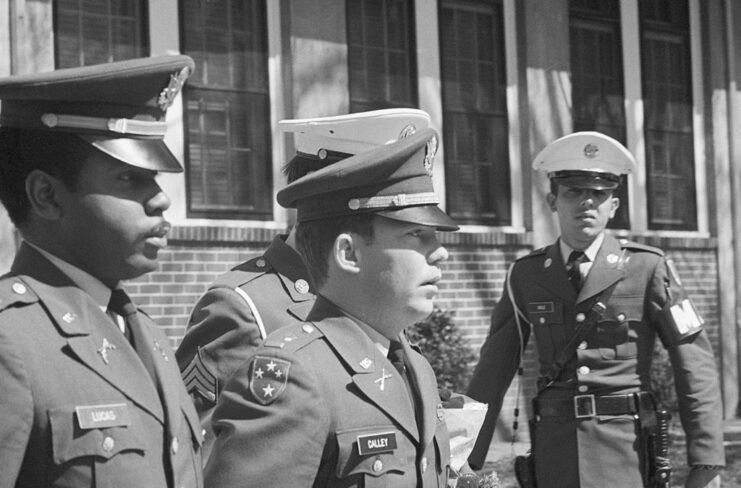
How do you think the Mỹ Lai Massacre spurred the anti-war movement in the United States at the time?
MARSHALL POE: For a few years before this, anti-war protesters had been pointing to civilian casualties as a reason to stop the war and the argument they basically made was from the point of whether we should be there or not, we cannot conduct this war ethically. They weren’t entirely wrong.
They were looking for atrocities. The press was looking for atrocities. The anti-war movement was looking for atrocities that they could use in the media to say we should not be there. In that way, Mỹ Lai was kind of a gift for them.
This was a real atrocity, no question about it, and one that these people in the Army tried to cover up, so it makes the Army look horrible. They used this to bolster their argument to America that the war cannot be fought ethically, and a lot of people become involved in this who were anti-war at the time. There were Congressional hearings about it and there was lots of coverage of it, obviously, and it was a very disconcerting thing for Americans to hear.
It’s really out of this context, incidentally, that you get the “crazy Vietnam veteran” image because one of the people who glommed on to this was a guy named Robert Lifton. He was a Yale psychiatrist and public intellectual, and he made the claim with a couple of other anti-war psychiatrists that the war itself was very psychologically damaging for the soldiers involved because of the nature of the fighting.
It’s hardly an original thing. In World War I, it was shell shock and [in] World War II it was combat fatigue. Now we have a new category and, initially, they called it, I kid you not, Vietnam War Syndrome – that’s what they called it. They went and they said that the reason that Mỹ Lai happened was because these people had been driven crazy, these soldiers, by the nature of fighting in Vietnam.
There were all kinds of things that follow the fighting in Vietnam that are psychologically damaging, and eventually Vietnam War Syndrome becomes Post-Traumatic Stress Disorder (PTSD). I mean, we can trace it very clearly, and these anti-war psychiatrists are behind it.
What’s interesting about that is if you look at the way in which Vietnam veterans returned to the United States and how well they did after they returned, it’s actually very good. According to most of the research, Vietnam veterans, of whom I know quite a few, did really well when they got back. The Army took great care to make sure they did really well.
This image we have of a homeless Vietnam vet, I mean, these people exist, of course, but it’s not statistically accurate. Most of them came back and they were fine, and they lived their lives and did really well in the American context. In fact, the rate of psychological casualties was lower in Vietnam than it was in WWII or Korea.
Okay, this is the Army saying this, you may not believe them, but that’s what they said. The Vietnam vets I know, one of whom was my uncle, he came back and integrated and lived a fine life.
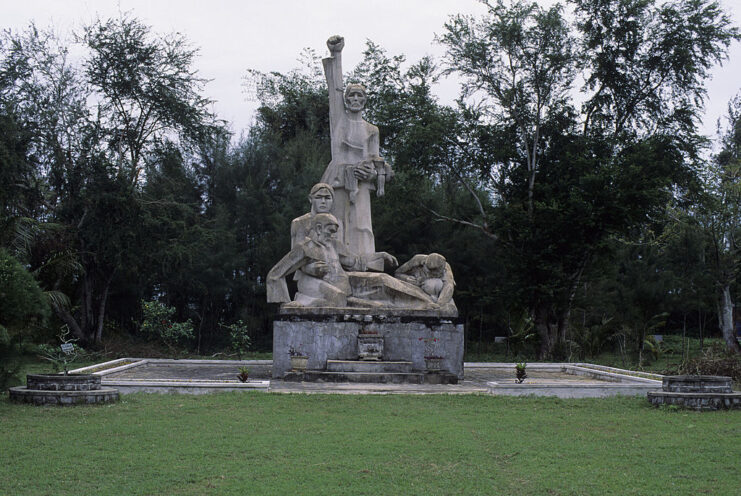
Finally, what would you say the legacy of the Mỹ Lai Massacre is and what can today’s society take from it?
MARSHALL POE: What I came to believe after spending 10 years with this thing is that the government, the US government, and the Army will tell the American people that they’re invading a country and conducting a war of counterinsurgency. That’s what they call it, [a] war of counterinsurgency.
The idea is that you have these highly-trained people, they go into this country, they find the bad guys, they kill them, leave the civilians alone, and then they leave and things are much better. That’s never happened. What actually happens is, we invade a country and occupy it, and that’s a very different framing.
Because when you invade a country, then the locals, be they in Iraq or Vietnam or Afghanistan or even today in Syria, they don’t want you there. They don’t like you. Now, they may be Communists or Baathists or jihadists or not, but they don’t want you there. They think to themselves, “Why are these Americans here? They’re supposedly trying to help us, but I don’t see any evidence of that.”
Of course, we never think of it as occupation because who occupies countries? We don’t do that. But, in fact, we do occupying this places, and in a dynamic like that you’re going to face a population that is really going to be quite hostile to you. If you look at the transcripts closely of Mỹ Lai, they say this a lot. So these people didn’t want us here. They were all hostile.
For example, one of the things they would be asked is, why did you kill civilians? And the soldiers would say, how do you know they were civilians? I don’t know who they were. They were all hostile to us. They didn’t want us there. They snipe us. They’re probably involved in setting up booby traps and mines. We don’t know that there are civilians. We don’t know who they are. We just know that they don’t like us and they may be deadly.
This sounds ridiculous, but if you’ve actually been in country for a long time, running these operations, it looks very different. If you really start to shoot first and ask questions later, if you don’t know who these people are and they’re hostile to you. Does that relieve them of any kind of culpability? Well, no, it doesn’t. Not at all. But it goes a little bit further up the chain of command, which is the American government and the Army going into these places and saying we’re there for counterinsurgency.
The big kind of policy takeaway or foreign policy is that you just have to be very clear eyed about what you’re doing when you invade and occupy a country, and the anti-war factions in the United States pointed out constantly that, from the military perspective, a war of counterinsurgency is incredibly difficult to pull off. You need people that are really incredibly well trained to do it.
The Vietnam-era Army, we sent over two million people there. They were well trained and they did a pretty good job of avoiding civilian casualties, all things considered, but only one Mỹ Lai, one is too many. So you just have to be clear eyed about what you’re doing there and tell the American people that we’re going to embark on something that is very difficult and it’s going to involve civilian casualties.
Can you conduct such a war morally? I don’t know. Outside some incredibly well trained force that would act appropriately in all circumstances. That’s not an Army of a million people. What you’re really asking is the military to do something you can’t do, and that’s bad.
So that’s the kind of primary message that I have. Now, again, I give great credit to the US Army, unlike many of my colleagues, for making sure this didn’t happen very often. […] The Army was very concerned with it, and they did a reasonably good job, but they couldn’t do a perfect job because it just does not allow for any sort of perfection.
More from us: INTERVIEW: Roxanne Panchasi Discusses Inaccuracies in Ridley Scott’s ‘Napoleon’
So that’s the big takeaway from my perspective.
